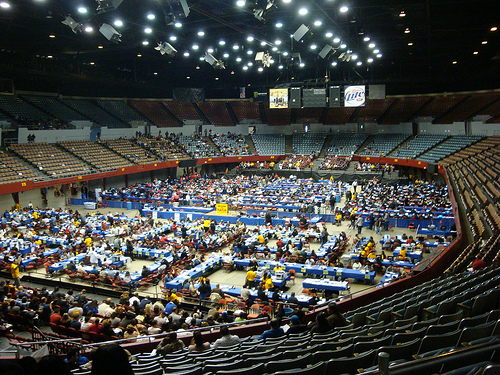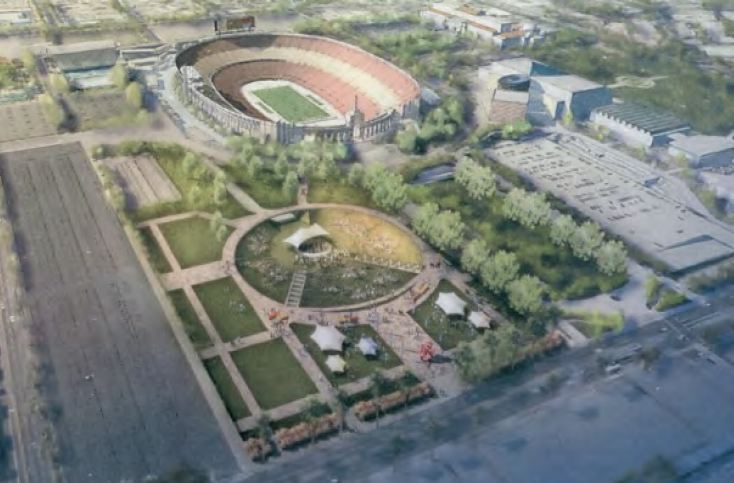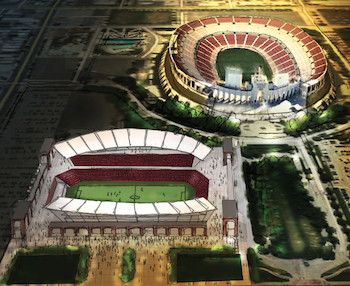For Exposition Park, A Soccer Stadium Or An Amphitheatre?

The Los Angeles Coliseum Commission voted Wednesday to move forward with a proposal to demolish the Sports Arena, opening the door for developers to submit plans to build either a soccer stadium or an amphitheater to replace the publicly managed, cash-strapped and deteriorating entertainment venue that has been short on programming.
The commission certified an environmental impact report covering both project ideas that found no major unsolvable problems would arise from the destruction-construction combination.
Coliseum management officials said they would like to see one of the ideas move forward as soon as possible, but no real estate developer has expressed strong interest in taking on the redevelopment.
While there has been some general interest, no one has been willing to write check to fund the proposal, said Jonathan Lee, the Coliseum's marketing director.
The only public comment received on the environmental impact report from a non-governmental agency was from real estate developer Jeffrey Stone, head of Phoenix-based Summit Builders. The business has an office in Lakewood as well. Five calls placed to Summit business administrator Allison Johnson to reach Stone for comment were not returned.
Stone blasted the commission for releasing the draft and having the public comment on it during the holiday season--just before Thanksgiving until New Year's Day--and questioned its ability to even spearhead the project.
"Holiday-timed public review has been used as a strategic advantage for controversial project (sic) to avoid meaningful comments on projects in the past," Stone wrote.
He called for the commission to ask the state Legislature for specific authority to undertake the redevelopment project, and he suggested they consider more alternatives.
At Wednesday's meeting, commissioner David Israel asked if certifying the report would preclude it from considering other alternatives at a later date. The answer: it would not. However, the report would need to be re-certified should the commission approve plans for either the soccer stadium or amphitheatre.
The commission faces a $1 billion budget shortfall for its current fiscal year, mainly because of low attendance and weak concessions sales at last year's USC football games. The nine-panel board oversees the 15-acre Sports Arena campus near Exposition Park as well as the Coliseum and some adjacent parking lots and fields.
The commission's moves come amid ongoing discussions between the state and USC to transfer the land under the properties. USC President Max Nikias said Tuesday to an audience of students that purchasing the land underneath the coliseum, sports arena and adjacent parking was not one of his "top priorities." Nikias said he and "key" USC trustees have been doing their "due diligence" about the deal, but it wasn't something he was pushing to get done immediately. Two USC trustees--Rick Caruso and Ed Roski Jr.--are local real estate developers. Caruso also sits on the Coliseum Commission.
The soccer stadium option is the third vision for a new sports facility in Los Angeles County, following Ed Roski's plan for an NFL stadium in the City of Industry and an AEG proposal for a $725 million stadium that would be designed to house an NFL team and the World Cup.
The Sports Arena has come under scrutiny during recent weeks because of electronic music festivals that regularly lead to hospitalizations for overdoses on the drug Ecstasy. The festivals have been one of the few steady streams of revenue for the aging facility, likely bringing in a few hundred thousand dollars annually. Four events annually have produced nearly a third of revenues. The venues have budgeted for $2.3 million in total revenues from all of its events this year.
The amphitheater option would feature an 800-square-foot stage backed by an open half-dome shell and a large grass field flanked by flag poles. Not included in the plans are any fixed seats, video boards or fencing. Concession stands and restrooms "may be provided," the report says. Events that could be held here include Farmer's Markets, rallies, festivals, exercise groups, concerts, neighborhood carnivals and special ceremonies.
The other option envisions a 22,000-seat Major League Soccer stadium, offering some competition to the Home Depot Center in Carson. The stadium plan calls for MLS games, exhibition games and USC soccer games to be played there. At the varsity level, USC only has a women's team. Local teams would be allowed to practice there as well.
The plan mentions no outisde retail or dining components--items that may ultimately be needed for financial viability, but may not be allowed under the area's land grant, which prohibits commercial enterprises.
The stadium, which would be oriented the same way as the arena is right now, would also hold concerts and rallies. If USC's team moves into this new stadium, it's current field near Hoover Street and 30th Street would likely become available for USC to develop on.
The seven-story Sports Arena opened 51 years ago amid a nationwide boom in arena construction, providing the region its first new sports venue in about 25 years.
Most of the arena's highlights came in its first few years of existence, hosting boxing, basketball, hockey, the 1960 Democratic National Convention and the 1961 Freedom Rally at which Dr. Martin Luther King Jr. spoke.
But professional sports franchises such as the Lakers and Kings quickly moved to other location such as The Forum and Pauley Pavilion. Only the Clippers would come play at the arena from 1984 to 1999.
During the past five years, an event has been held there, on average, only once every six days. Nearly all of the events attracted less than 10,000 people. In comparison, the Staples Center held about four times as many events, according to the website of its owner, AEG.
Most of the environmental impacts mentioned in the final report are routine ones that one would expect from a major construction project. Lighting and noise may anger residents living along Martin Luther King Jr. Boulevard. But because the Sports Arena is built in a big ditch, the stadium and amphitheater would also maintain low profiles.
The parking and traffic situation would also change very little because even if the Coliseum and Sports Arena held concurrent events, overall capacity would be limited to about the same level as right now. About 20,000 parking spaces exist throughout Exposition Park and USC, and no additional ones would have to be added.
The report states the Sports Arena needs $8.2 million in upgrades--from new seats to new plumbing and heating systems--within the next five years to keep operating. Each of the past five fiscal years, however, has brought operating losses totaling nearly $4 million. Because the commission doesn't receive any taxpayer subsidies, it doesn't have the cash to pay for those fixes. The document notes that even if improvements were made, the Sports Arena would not be any more competitive with venues such as the 19,000-seat Staples Center.
The arena's present configuration allows it hold about 15,000 people for hockey, boxing and basketball events.
The 45-day public comment period on the draft report runs until Dec. 30. It seems wise for public agencies, including the L.A. City Council and the L.A. County Board of Supervisors, to ask for an extension of that comment period since it runs right through two major holiday periods.
Either way, comments should be directed to Coliseum general manager Pat Lynch at 3939 S. Figueroa St., Los Angeles, CA 90037. The report is available online, at the previous address and at the Exposition Park Library. The online PDF is also "secured," so text from the document can't be copied and pasted.
Under a joint agreement between the state, city and county, the Coliseum Commission maintains and operates the Coliseum and Sports Arena. That agreement runs through 2054.
Los Angeles voters thrice rejected measures to publicly finance the construction of a Downtown sports arena. Urged on by County Supervisor Kenneth Hahn, the state Legislature eventually jumped in, authorizing in 1958 the sale of $7 million in bonds to build the present arena. Before the Exposition Park project was settled on, there were three competing visions of "world-class" arenas across Los Angeles.
The Coliseum has stood since 1923. The commission has existed since 1945.
Below is a very preliminary concept drawing of what the amphitheater may look like:

And here's a look at similar sketch of the soccer stadium.

To reach reporter Paresh Dave, click here.
Find him on Twitter: @peard33.



